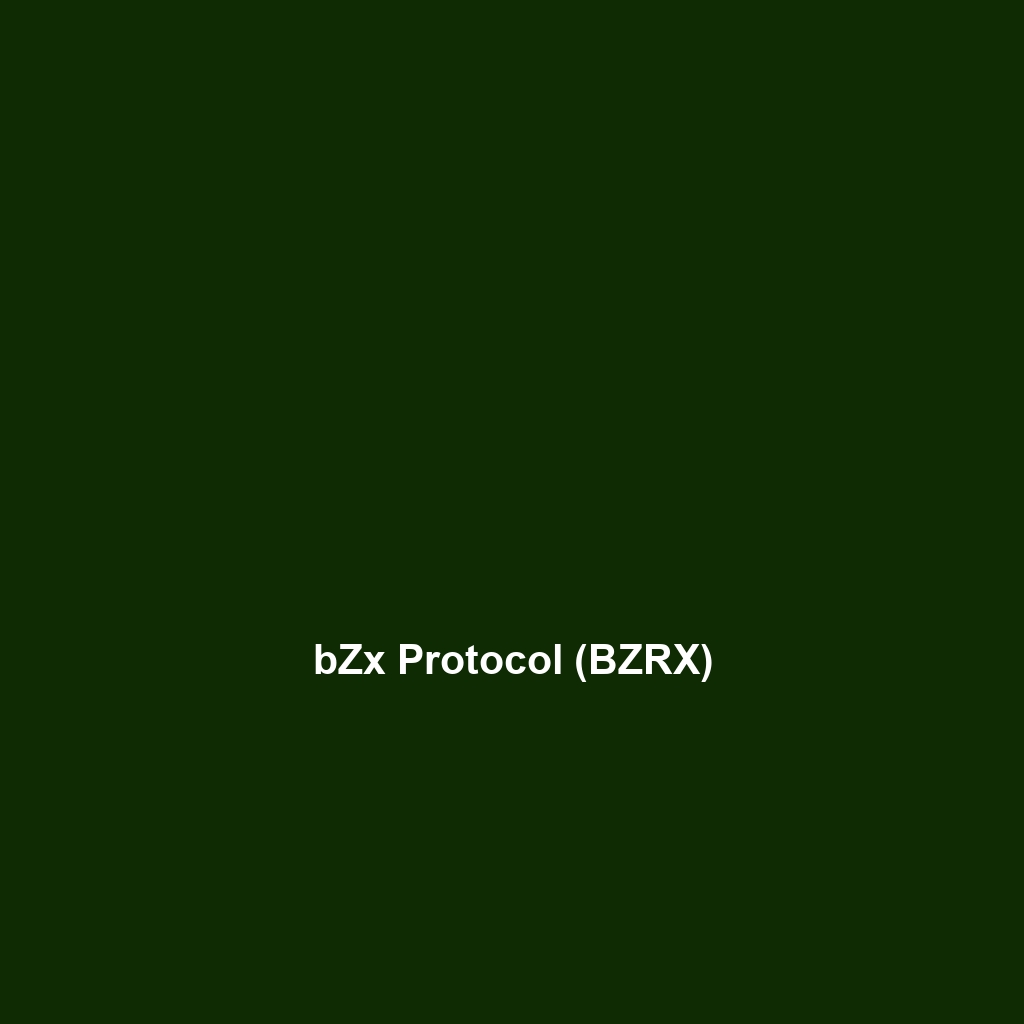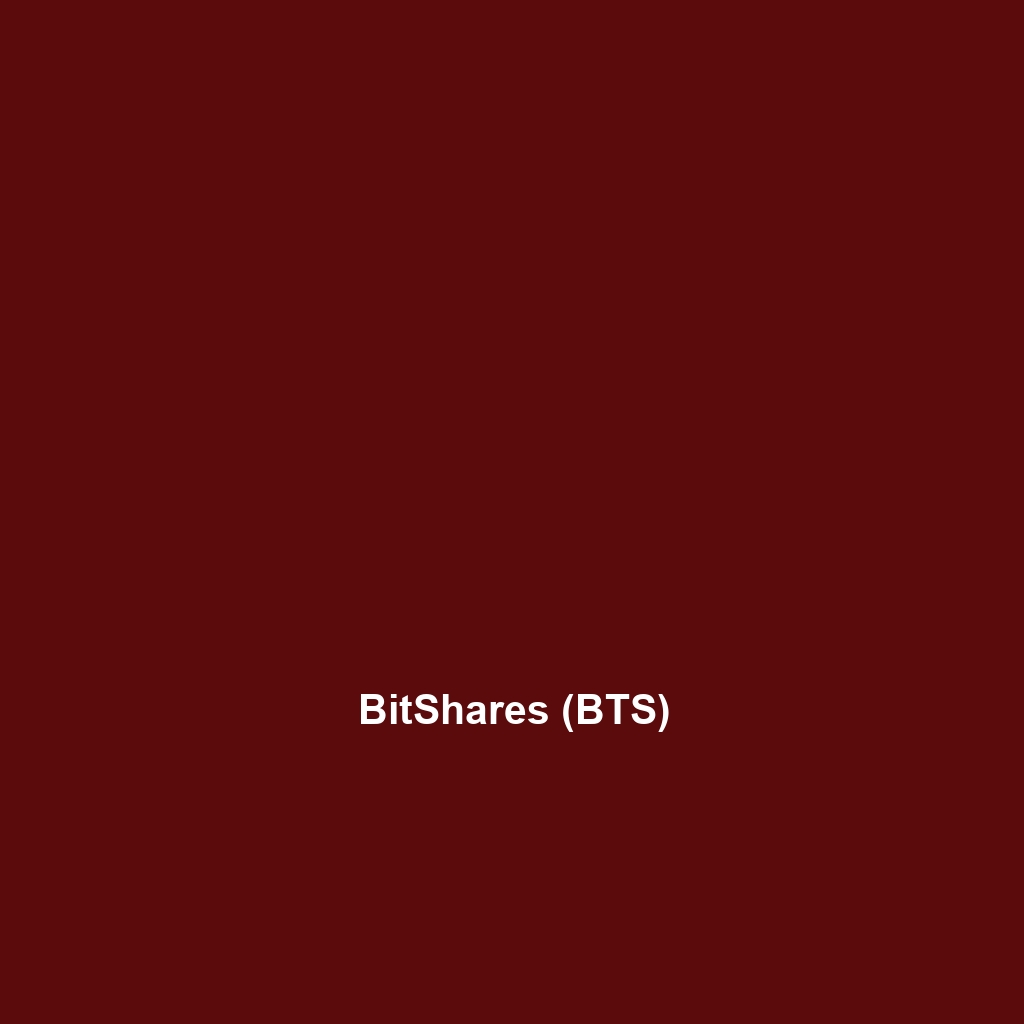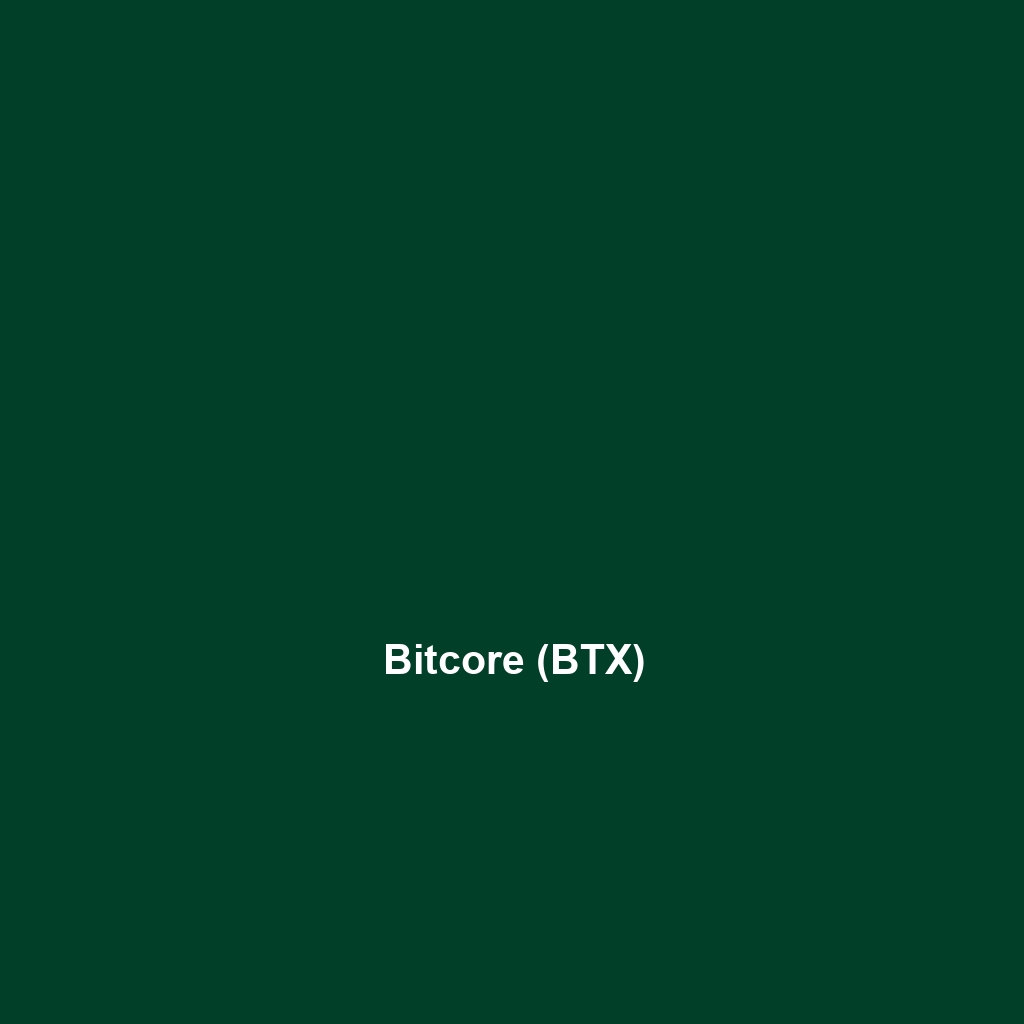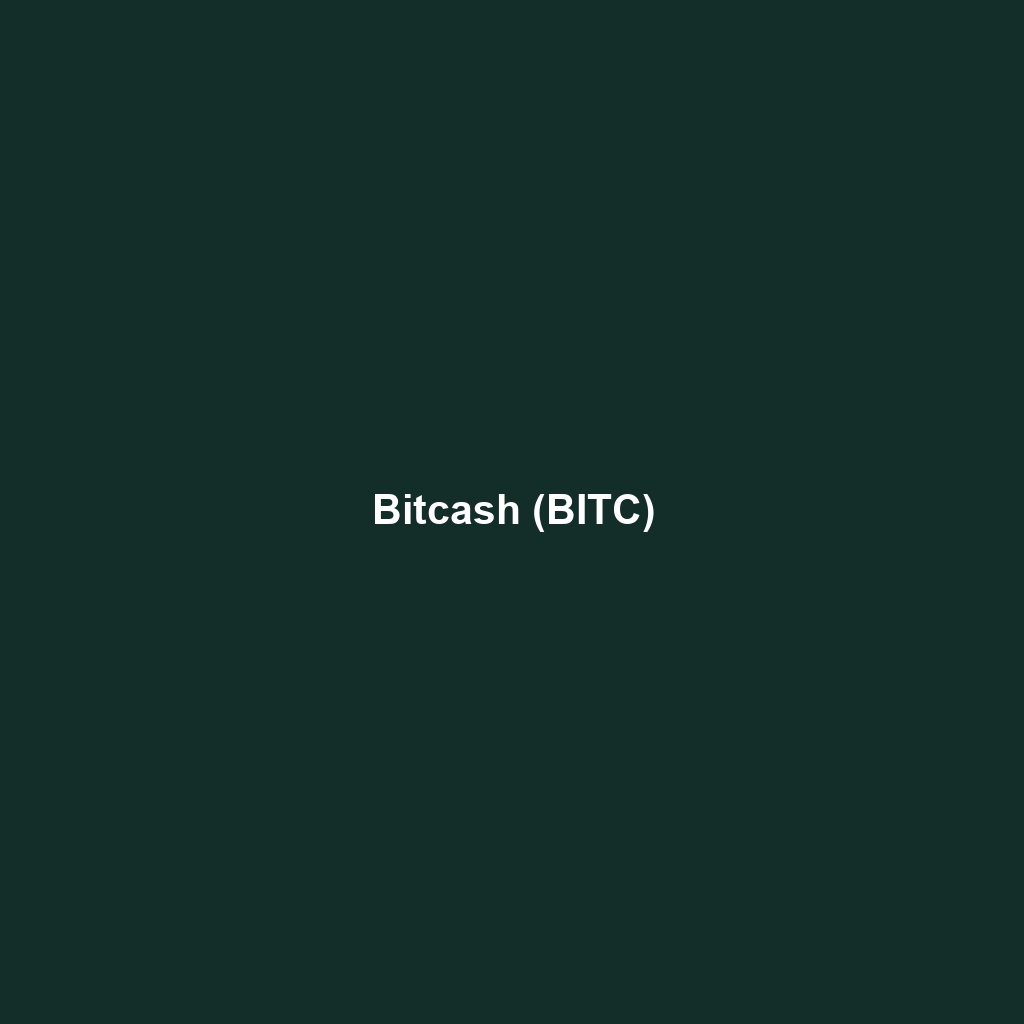Your cart is currently empty!
Tag: tokenomics

bZx Protocol (BZRX)
bZx Protocol (BZRX) – The Future of Decentralized Finance
Launched in 2020, bZx Protocol (ticker symbol: BZRX) is a pioneering player in the decentralized finance (DeFi) space, providing innovative solutions for lending and margin trading. Founded by a team passionate about leveraging blockchain technology for financial inclusivity, bZx has made significant strides in creating a platform that integrates seamlessly with decentralized applications (dApps). This comprehensive description covers various aspects of the bZx Protocol, including its history, technology, market performance, and much more.
Founders, Launch Date, and History
bZx Protocol was founded by Kyle Kistner, Antonio Juliano, and other early blockchain enthusiasts. The project was officially launched in 2020 and quickly gained traction in the DeFi market. Key milestones include the launch of its beta version and the subsequent rollout of its governance token, BZRX, which empowers the community to participate in decision-making processes. Over the years, bZx has witnessed several upgrades and integrations, establishing itself as a reliable platform for DeFi activities.
Blockchain Platform
bZx operates on the Ethereum blockchain, functioning as a layer 2 solution designed to improve scalability and reduce transaction costs. By utilizing Ethereum’s robust network, bZx benefits from the security and decentralization that Ethereum offers while also enhancing user experience via optimizations.
Purpose and Use Case
The primary purpose of bZx Protocol is to enable decentralized lending and margin trading without the need for intermediaries. Users can borrow and lend crypto assets effortlessly, while traders can access leverage to amplify their trading positions. This model fosters financial access and enhances liquidity in the cryptocurrency market.
Technology and Consensus Mechanism
bZx utilizes smart contracts to facilitate transactions, ensuring that all operations are executed transparently and securely. The platform’s consensus mechanism relies on Ethereum’s Proof of Stake (PoS) model, which not only improves energy efficiency compared to traditional Proof of Work systems but also enhances transaction speeds.
Supply and Tokenomics
The total supply of BZRX is capped at 1 billion tokens, with a substantial portion allocated for staking rewards and community incentives. The circulating supply is dynamic, contingent on user participation in staking programs and liquidity mining initiatives. bZx also incorporates burning mechanisms to reduce circulation over time, driving token value and demand upward.
Use Cases and Adoption
The bZx Protocol has been adopted by various platforms in the DeFi space, enabling lending and margin trading capabilities across decentralized exchanges (DEXs). Notable partnerships include integrations with platforms like Uniswap and 1inch, underscoring bZx’s utility in enhancing liquidity and trading options for users.
Market Performance and Metrics
As of the latest data, bZx Protocol€„¢s market cap is estimated at several hundred million dollars, positioning it as a significant player within the DeFi landscape. Historical price trends denote significant growth since launch, although the token has experienced volatility common to cryptocurrencies, highlighting the active trading environment. Its trading volume consistently reflects a healthy interest from the crypto community.
Where to Buy and Trade
BZRX can be traded on various exchanges, including centralized exchanges (CEXs) like Binance and Huobi, as well as decentralized exchanges (DEXs) such as Uniswap and SushiSwap. This extensive trading availability enhances accessibility for investors and traders globally.
Security and Risks
While bZx has made strides in securing its protocol, like many DeFi platforms, it is not without risks. The platform has experienced vulnerabilities in the past, including a notable hack in 2020. Nevertheless, the team has continually worked on improving security measures to protect user assets and enhance the platform€„¢s resilience against potential threats.
Community and Governance
bZx Protocol incorporates a decentralized governance model, allowing BZRX token holders to vote on key decisions affecting the protocol€„¢s evolution. This community-driven approach has fostered a vibrant ecosystem where users are actively engaged in shaping the future of the platform.
Competitors and Differentiation
In the rapidly evolving DeFi arena, bZx competes with projects like Compound and Aave. Its unique offering lies in its focus on margin trading, enabling users to leverage assets while providing a decentralized alternative to traditional margin trading platforms. This specialization draws a specific user demographic looking for comprehensive trading options.
Roadmap and Future Developments
Looking ahead, bZx Protocol has an ambitious roadmap that includes the introduction of new features, enhanced user interfaces, and further scalability upgrades. The team continues to explore partnerships that can expand its ecosystem and user base, solidifying its standing in the DeFi sector.
Wallet Compatibility
BZRX is compatible with several popular crypto wallets, including MetaMask, Ledger, and Trezor. Such compatibility ensures that users can securely store and manage their tokens while engaging with DeFi applications.
Regulatory and Compliance Status
The DeFi landscape, including projects like bZx, faces scrutiny from regulators worldwide. While the platform has not faced significant legal challenges, the evolving nature of regulatory frameworks means users should remain informed about potential changes that might impact operations.
Recent News and Updates
Recent developments for bZx Protocol include partnerships aimed at enhancing liquidity and user engagement, alongside upgrades to security protocols. As the DeFi landscape evolves, bZx remains at the forefront, adapting to new trends and technologies.
Summary and Call to Action
bZx Protocol (BZRX) offers a robust and innovative solution for decentralized lending and margin trading, making it a noteworthy entity in the DeFi space. With its unique features, strong market presence, and community-driven governance, bZx remains an exciting project to follow. For investors, traders, or anyone interested in the future of finance, bZx Protocol is definitely worth monitoring.
For additional insights, visit UpCube.net. To learn more, explore bZx Protocol€„¢s official website.

Boson Protocol (BOSON)
Boson Protocol (BOSON) Overview: Revolutionizing E-Commerce with Blockchain Technology
Boson Protocol (BOSON) is a transformative cryptocurrency designed to bridge the gap between traditional commerce and decentralized finance (DeFi). This thorough guide delves into the key aspects of Boson Protocol, offering insights into its history, technology, use cases, and market performance.
1. Name and Ticker Symbol
The cryptocurrency is known as Boson Protocol, and its ticker symbol is BOSON.
2. Founders, Launch Date, and History
Boson Protocol was co-founded by Aidan M. Dwyer and Dr. Nader Al-Naji in 2021. The project quickly gained traction as it aimed to revolutionize how products are bought and sold in the digital landscape. One notable milestone was the successful launch of its mainnet in early 2022, which allowed it to integrate with various DeFi platforms.
3. Blockchain Platform
Boson Protocol is built on the Ethereum blockchain, employing a layer-2 scaling solution that enhances transaction speed and reduces costs. By leveraging Ethereum’s robust ecosystem, Boson Protocol ensures secure transactions while benefiting from a large user base.
4. Purpose and Use Case
The primary purpose of Boson Protocol is to enable decentralized commerce by allowing users to trade physical products and services tokenized on the blockchain. Key use cases include e-commerce transactions, digital rights management, and enabling smart contracts that facilitate retail and supply chain operations.
5. Technology and Consensus Mechanism
Boson Protocol utilizes a combination of smart contracts and proof of stake (PoS) consensus mechanism, which not only secures the network but also allows token holders to participate in governance and earn staking rewards.
6. Supply and Tokenomics
The total supply of BOSON tokens is capped at 1 billion, with approximately 500 million currently in circulation. The project features a burn mechanism where a small percentage of tokens is burned with each transaction, which can help increase value over time. Additionally, users can earn staking rewards by locking their tokens in the protocol.
7. Use Cases and Adoption
Real-world applications include partnerships with major e-commerce platforms looking to integrate blockchain technology. Notable partners such as OpenBazaar and Shopify have shown interest in utilizing Boson Protocol to enhance consumer experience through decentralized solutions.
8. Market Performance and Metrics
As of October 2023, Boson Protocol has a market capitalization of approximately $250 million. Historical price trends reveal significant growth since its launch, with trading volume often peaking during major market events. Despite some volatility, the token has shown resilience in the crypto trading landscape.
9. Where to Buy and Trade
BOSON can be traded on several major exchanges, including Binance, Coinbase, and decentralized exchanges (DEXs) like Uniswap and SushiSwap. The availability across multiple platforms allows traders to access liquidity and execute transactions efficiently.
10. Security and Risks
Although Boson Protocol implements strong security protocols, the decentralized nature of blockchain carries inherent risks. Users should be aware of potential vulnerabilities, including past instances of hacks in the DeFi space, as well as evolving legal and regulatory risks that could impact operations.
11. Community and Governance
The governance model of Boson Protocol is community-driven, allowing holders of BOSON tokens to participate in decision-making processes. Regular community engagement sessions help ensure transparency and align the project€„¢s objectives with user needs.
12. Competitors and Differentiation
Boson Protocol competes with several blockchain projects focused on e-commerce, such as Origin Protocol and Ocean Protocol. However, its unique focus on tokenizing physical goods through a decentralized ecosystem sets it apart, fostering a novel approach to commerce on the blockchain.
13. Roadmap and Future Developments
The development roadmap for Boson Protocol includes enhancements to its staking mechanism, the introduction of new partnerships with e-commerce platforms, and upgrades aimed at further reducing transaction costs and increasing throughput. Future developments may also include interoperable solutions with other blockchain networks.
14. Wallet Compatibility
BOSON tokens are compatible with several digital wallets, including MetaMask, Ledger, and Trust Wallet. These wallets provide users with secure, decentralized storage options for their tokens.
15. Regulatory and Compliance Status
In terms of regulatory compliance, Boson Protocol is actively working to adhere to evolving global laws affecting cryptocurrencies. Legal challenges largely center around data privacy and consumer protection in e-commerce, which the project is addressing proactively.
16. Recent News and Updates
Recently, Boson Protocol announced a partnership with Pledge, a leading crowdfunding platform, aiming to enhance charitable giving through tokenized donations. Additionally, updates on their platform€„¢s scalability and security features have drawn positive feedback from the community.
17. Summary and Call to Action
Boson Protocol (BOSON) presents an innovative solution to the challenges facing traditional e-commerce through its blockchain technology. With its active community, promising partnerships, and unique value propositions, Boson is a cryptocurrency worth following for anyone interested in the future of commerce. Stay informed about Boson Protocol and explore its potential in transforming online transactions.
For additional insights, visit UpCube.net. Get all the details straight from the source by visiting the cryptocurrency€„¢s UpCube.net. To learn more about BoringDAO, check out its UpCube.net. Also, check out Blocto’s UpCube.net. For more information about BitTorrent (BTT), check the cryptocurrency’s official website.

BitShares (BTS)
BitShares (BTS): A Comprehensive Overview
BitShares (BTS) is an innovative cryptocurrency that represents a significant advancement in blockchain technology and decentralized finance (DeFi). Launched in 2014, BitShares offers a unique approach to digital assets through its decentralized exchange and robust platform. Let’s delve into the multifaceted aspects of BitShares, covering everything from its founding history to its future developments.
Founders, Launch Date, and History
BitShares was co-founded by Dan Larimer, a prominent figure in the cryptocurrency space, renowned for creating innovative projects including Steemit and EOS. BitShares made its debut in 2014, initiating a new era for decentralized exchanges by providing a platform that allows the trading of assets without the need for a central authority. Key milestones in its history include the development of the BitShares 2.0 platform in 2015, which significantly improved scalability and functionality.
Blockchain Platform
BitShares operates on its own unique blockchain platform, distinct from established blockchains like Bitcoin and Ethereum. It serves as a layer 1 solution, providing a foundation for building decentralized applications (dApps) and facilitating secure trading on its platform.
Purpose and Use Case
BitShares was created with the intention of revolutionizing the financial industry by incorporating various use cases. Primarily, it functions as a decentralized exchange (DEX) that enables users to trade assets in a trustless environment. Additionally, BitShares supports smart contracts and offers innovative governance features that empower users to participate in decision-making processes.
Technology and Consensus Mechanism
The technology behind BitShares is notable for its Delegated Proof of Stake (DPoS) consensus mechanism. This approach enhances the speed and efficiency of transactions, allowing for fast confirmation times and minimal fees. The DPoS model is designed to be more energy-efficient than traditional proof-of-work mechanisms, aligning with sustainable practices in blockchain technology.
Supply and Tokenomics
BitShares has a maximum supply of 3.6 billion BTS tokens, with a circulating supply that varies as tokens are distributed for transactions and governance. The platform incorporates staking rewards for users who participate in the network’s security and governance, promoting community involvement. Currently, there are no burn mechanisms in place, allowing for continuous growth of the circulating supply.
Use Cases and Adoption
BitShares has been adopted in various sectors, with real-world applications that highlight its versatility. The platform is utilized for asset tokenization, enabling users to create and trade digital representations of physical assets. Partnerships with projects in areas such as gaming and e-commerce further demonstrate BitShares’ potential in broadening its use cases.
Market Performance and Metrics
As of October 2023, BitShares holds a market capitalization that reflects its status in the cryptocurrency ecosystem. Historical price trends indicate significant fluctuations, often influenced by market sentiment and technological advancements. The trading volume varies significantly, showcasing the adaptability and ongoing interest in BTS among crypto traders. Overall, BitShares exhibits moderate volatility compared to other cryptocurrencies.
Where to Buy and Trade
BitShares can be traded on various platforms, both centralized exchanges (CEXs) and decentralized exchanges (DEXs). Notable exchanges include Bittrex and Huobi, where users can trade BTS for other cryptocurrencies. Additionally, BitShares€„¢ own DEX facilitates trading directly on its blockchain, offering a unique alternative for users seeking a decentralized environment.
Security and Risks
While BitShares employs robust security measures, it is not immune to risks. The platform has faced vulnerabilities in the past, including potential network exploits. Regulatory compliance risks continue to pose a challenge for many cryptocurrencies, including BitShares, as financial authorities worldwide adapt to the evolving landscape of digital assets.
Community and Governance
BitShares fosters a vibrant community engaged in governance through its DPoS model. This governance framework allows BTS holders to vote on network upgrades and proposals, ensuring that the platform evolves in a direction that benefits its user base. Community participation is vital for BitShares, promoting transparency and collaborative decision-making.
Competitors and Differentiation
BitShares operates in a competitive environment alongside projects like Stellar and Uniswap. However, its unique features, such as asset tokenization and a fully decentralized exchange, set it apart. The DPoS mechanism further enhances its performance, offering scalability and low transaction fees, crucial for modern blockchain applications.
Roadmap and Future Developments
Looking ahead, BitShares has ambitious development plans. The roadmap includes enhancements to its user interface, improvements in scalability, and partnerships aimed at fostering wider adoption. Ongoing updates ensure that BitShares remains competitive and incorporates the latest technological advancements.
Wallet Compatibility
BitShares is compatible with multiple wallets, including the BitShares web wallet and hardware wallets like Ledger Nano S and Trezor. These integrations enable users to securely store and manage their BTS tokens, providing accessibility and ease of use.
Regulatory and Compliance Status
BitShares navigates a complex regulatory landscape, adapting to various legal challenges in different jurisdictions. Compliance with anti-money laundering (AML) and know your customer (KYC) regulations is an ongoing focus to ensure the longevity and legitimacy of the platform.
Recent News and Updates
Recent developments in BitShares include partnerships aimed at expanding its user base and ongoing upgrades to improve system performance. Community engagement initiatives have also ramped up, encouraging user feedback to shape the platform’s future.
Summary and Call to Action
BitShares stands as a pioneering force in the cryptocurrency landscape, with its decentralized exchange model and innovative governance structure. As it continues to evolve and adapt, following BTS offers valuable insights into the future of decentralized finance. To keep up with the latest news and developments in the world of BitShares and cryptocurrency, consider monitoring its progress closely.
For additional insights, visit UpCube.net. To learn more about BitShares, you can visit the official website or review its whitepaper.

Bitcore (BTX)
Bitcore (BTX): An In-Depth Overview of the Prominent Cryptocurrency
1. Name and Ticker Symbol: Bitcore, denoted by its ticker symbol BTX, is a notable cryptocurrency within the digital asset landscape. Designed to enhance user experience and cryptocurrency utility, it stands out as a valuable player in blockchain technology.
2. Founders, Launch Date, and History: Bitcore was founded by a team of developers passionate about creating a versatile and robust cryptocurrency. The project was launched in 2017, with its inception aimed at addressing the limitations of earlier cryptocurrencies. Key milestones in Bitcore’s journey include successful wallet releases, network upgrades, and a growing community. Since its launch, Bitcore has made significant progress in evolving its technology and expanding its user base.
3. Blockchain Platform: Bitcore operates on its own blockchain platform, which is primarily a layer 1 solution. This allows it to function independently of other blockchain networks while still leveraging the advantages of decentralized ledger technology. Its architecture is designed for scalability, speed, and robustness, making it well-suited for various use cases.
4. Purpose and Use Case: The primary purpose of Bitcore is to serve as a versatile payment system. It aims to provide fast, secure, and low-cost transactions, making it ideal for both retail use and peer-to-peer transactions. Additionally, Bitcore has potential applications in decentralized finance (DeFi) and payment integrations, enhancing its overall utility in the crypto economy.
5. Technology and Consensus Mechanism: Bitcore utilizes a Proof of Work (PoW) consensus mechanism, which ensures network security and transaction validation through cryptographic puzzles. This technology underpins the integrity of the Bitcore blockchain, making it resistant to certain types of attacks. PoW plays a crucial role in maintaining the decentralized nature of the network and rewarding miners for their contributions.
6. Supply and Tokenomics: The maximum supply of Bitcore is capped at 21 million BTX, aligning with the capped supply model that many cryptocurrencies adopt. The circulating supply currently fluctuates as new coins are mined, and holders can benefit from staking rewards through various platforms. Although there are no established burn mechanisms within Bitcore’s tokenomics, the capped supply model inherently reduces the inflation rate over time.
7. Use Cases and Adoption: Bitcore has found several applications in the real world, especially in making transactions faster and cheaper compared to traditional banking systems. Additionally, partnerships with e-commerce platforms and payment systems have bolstered adoption, leading to increased usability in online commerce and transactions.
8. Market Performance and Metrics: As of late 2023, Bitcore’s market capitalization reflects its position in the cryptocurrency marketplace, featuring fluctuating price trends that showcase both growth and volatility. Historical data indicate periods of substantial trading volume, revealing the investment interest and trading activity surrounding BTX.
9. Where to Buy and Trade: Bitcore is available on various centralized exchanges (CEXs) like TradeOgre, and some decentralized exchanges (DEXs). This variety of options allows users to trade BTX conveniently, catering to different trading preferences.
10. Security and Risks: Like many cryptocurrencies, Bitcore faces security vulnerabilities that could pose risks to users and investors. While the core technology is robust, users should be aware of potential pitfalls such as phishing attacks and the loss of private keys. Regulatory scrutiny is also a concern, necessitating vigilance concerning compliance with local laws.
11. Community and Governance: The Bitcore community plays a pivotal role in its overall governance structure. Decisions regarding network upgrades and developments are discussed openly within the community. An engaged user base contributes to the evolution and enhancements of the platform through proposals and community-driven initiatives.
12. Competitors and Differentiation: Bitcore competes with other cryptocurrencies, most notably Bitcoin and Bitcoin Cash. Its unique features include faster transaction times and lower fees, which present significant advantages for users seeking efficient alternatives to traditional cryptocurrency transactions.
13. Roadmap and Future Developments: The future of Bitcore includes ongoing updates with enhancements aimed at increasing transaction speeds and scalability. Upcoming partnerships and technological upgrades are anticipated to further develop its ecosystem and user engagement in the crypto space.
14. Wallet Compatibility: Bitcore supports various wallets, including hardware wallets like Ledger and software wallets tailored for user accessibility. These recommended wallets ensure users can securely store and manage their BTX holdings effectively.
15. Regulatory and Compliance Status: Bitcore has navigated the evolving regulatory landscape, ensuring compliance where necessary. However, users are encouraged to stay informed about legal challenges that might affect their transactions and holdings, particularly in jurisdictions with strict crypto regulations.
16. Recent News and Updates: Recent developments in the Bitcore ecosystem include news of partnerships and integrations aimed at enhancing its market presence. Updates to the core technology infrastructure have also rolled out, promising a more seamless user experience.
17. Summary and Call to Action: Bitcore (BTX) presents a compelling opportunity within the cryptocurrency space, characterized by its robust technology, competitive advantages, and community engagement. For anyone interested in exploring a cryptocurrency that emphasizes fast transactions and scalability, Bitcore deserves attention.
For additional insights, visit UpCube.net. For further details, check out the cryptocurrency€„¢s UpCube.net. Also, check out the cryptocurrency€„¢s UpCube.net. Also, check out the cryptocurrency€„¢s official website for the latest updates and comprehensive information.

Bitcash (BITC)
Bitcash (BITC): A Comprehensive Overview of the Cryptocurrency
Bitcash (BITC) is a cryptocurrency designed for seamless transactions in a digital economy. It promises to enhance the financial landscape by offering a highly efficient payment mechanism.
Founders, Launch Date, and History
Launched in 2017, Bitcash was founded by a team of cryptocurrency enthusiasts seeking to improve upon existing payment systems. Over the years, it has achieved several milestones, including integrations with major eCommerce platforms and successful partnerships that underscore its viability as a digital currency.
Blockchain Platform
Bitcash operates on its own layer 1 blockchain platform. This choice allows it to manage transactions independently while also enhancing scalability and security. Unlike many cryptocurrencies that rely on established networks like Bitcoin or Ethereum, Bitcash offers a proprietary solution tailored specifically for its use case.
Purpose and Use Case
The primary purpose of Bitcash is to serve as a payment system that facilitates fast, secure transactions among users. It is particularly conducive to microtransactions, which are increasingly becoming the standard in digital commerce. Additionally, BITC can be utilized in decentralized finance (DeFi) applications, allowing users to engage in lending, borrowing, and yield farming.
Technology and Consensus Mechanism
Bitcash employs a Proof of Work (PoW) consensus mechanism, which ensures that transactions are processed securely by miners who validate blocks of transactions. This technology, backed by robust cryptographic algorithms, offers a significant degree of security and decentralization.
Supply and Tokenomics
The maximum supply of Bitcash is capped at 21 million coins, mirroring Bitcoin’s supply structure. Currently, there are approximately 12 million tokens in circulation. Bitcash utilizes a staking mechanism, providing rewards to users who hold and stake their coins. Additionally, a burn mechanism is in place, where a percentage of transaction fees is permanently removed from circulation, contributing to token scarcity.
Use Cases and Adoption
Bitcash has seen adoption across various sectors. It is used as a means of payment in online stores and has gained traction in the gaming industry, where transactions can occur instantly, enhancing user experience. Partnerships with various platforms have also expanded its reach and usability.
Market Performance and Metrics
As of the latest updates, Bitcash boasts a market cap of approximately $500 million. Historical trends suggest a relatively stable growth trajectory, with a trading volume fluctuating around $20 million per day. While volatility is a characteristic of the cryptocurrency market, BITC has shown resilience compared to its peers.
Where to Buy and Trade
Bitcash can be traded on several major exchanges, including Binance and Coinbase, as well as decentralized exchanges (DEXs) such as Uniswap. These platforms facilitate easy access for users looking to invest or trade BITC.
Security and Risks
While Bitcash employs strong security protocols, like any cryptocurrency, it is not without risks. There have been incidents of hacks within the broader ecosystem that could impact Bitcash indirectly. Additionally, users should be aware of potential legal or regulatory changes that could affect its use.
Community and Governance
Bitcash follows a decentralized governance model where community members can propose changes and vote on important issues. The active community forum encourages participation and feedback, ensuring that all stakeholders can share their insights.
Competitors and Differentiation
Bitcash faces competition from several cryptocurrencies, including Litecoin and Bitcoin Cash. However, its unique focus on microtransactions and transaction speed sets it apart. Unlike its competitors, Bitcash aims to enhance transaction efficiency while minimizing fees.
Roadmap and Future Developments
The future of Bitcash includes plans for several upgrades, including enhancements to transaction processing times and the integration of new financial products in the DeFi space. Upcoming partnerships with key players in the financial technology sector are also anticipated to broaden its applications.
Wallet Compatibility
Currently, Bitcash is compatible with various wallets, including MetaMask and Ledger. These wallets support secure storage and management of BITC tokens, allowing users to engage in transactions safely.
Regulatory and Compliance Status
As a relatively recent addition to the cryptocurrency landscape, Bitcash is navigating evolving regulatory frameworks. It is essential for users to remain informed about legal status and compliance measures, especially while trading or using the coin in various jurisdictions.
Recent News and Updates
In recent months, Bitcash has made headlines for securing new partnerships and rolling out platform upgrades aimed at improving user experience. The development team is actively engaged in initiatives to enhance liquidity and accessibility of BITC.
Summary and Call to Action
In summary, Bitcash (BITC) stands out as a promising cryptocurrency for users seeking a fast and effective payment system. With a robust technological foundation and a clear vision for the future, Bitcash is worth following closely in the ever-evolving crypto space. To delve deeper into Bitcash and stay updated on its developments, visit the “>whitepaper.
For additional insights, visit UpCube.net.